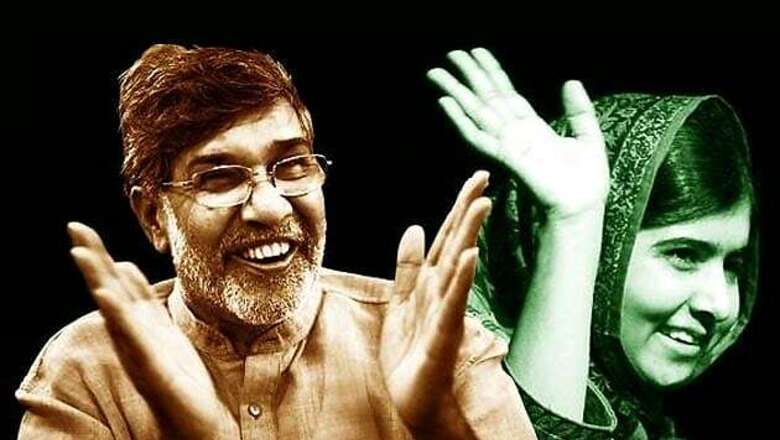
views
And the 2014 Nobel Peace Prize goes to Pakistan's Malala Yousafzai and India's Kailash Satyarthi. The announcement on October 10, 2014 -- a date that will be etched in history -- was unexpected, what to say of ironical. As the hostile neigbours in a hot-cold-tepid-warm-icy relationship since 1947 shot across one another's border, the 17-year-old education activist Yousafzai and the 60-year-old child rights activist Satyarthi congratulated one another.
As they planned to work together to improve the lives of children of their countries, and globally, their countries' armies shot indiscriminately across the borders killing children. It's irrelevant if the child's name is Mohammad or Ram; the bitter reality is the senseless end to a life that had nothing to do with the convoluted geopolitical dynamic, the nauseous display of machismo. It has got to end, and not a bullet too soon. Easier said than done.
I don't claim to be an analyst, nor do I've any pretension of understanding what goes for Pakistan-India power dynamic. This is not an in-depth look at the what/how/why of an ongoing state of war between my homeland and its closest neighbour. It's merely my shaking-of-head at what appears to me the colossal recklessness of a few angry men, which threatens the very fragile [im] balance of that threadbare line that stops the two nuclear-armed countries to announce an open war.
Pakistan-India border skirmishes are neither new nor particularly unpredicted. In repetition of a pattern, ostensibly, Pakistan indulges in a series of shelling/firing at Indian security forces' posts, thus engendering enough distraction for infiltration of militants/freedom fighters (the vocabulary varies as per the perception/justification) into "Indian-occupied" Kashmir (the focal point of Pak-India animosity, or let's just call it what it is, enmity since 1947.
While India would love to retake the "Pakistan-occupied" Kashmir, the repeated insistence that it has never taken any step to violate the LoC is pooh-poohed by almost all Pakistan governments and the Establishment. Shelling begins; India reacts on a ten-bullets-to-one ratio; civilian casualties escalate; angry hyperbole roars throughout media on both sides; hawks threaten a doomsday scenario; government spokespersons mouth tough-sounding admonitions; social media debates between Pakistanis and Indians convolute into outright hatred of one another; and then the firing stops. Just another LoC disturbance, and things lull into that deceptive semblance of normalcy that threatens to break into slivers at a bullet's notice.
What's so different this time? Nothing truly. The blame game is repetitively expected, and although the power paradigm is of one side being visibly superior in terms of its size and resources, there doesn't appear to be any relenting in the posturing that goes for nationalism in the region known colloquially as the Subcontinent. On Eid-ul-Adha, the news came of heavy firing between the Pakistani and Indian forces along the Sialkot working boundary and the Jammu, Poonch and Samba districts along the LoC. The reaction: predictable. While Pakistani Rangers substantiated their firing as response to "unprovoked" Indian shelling, Indian BSF personnel stated the usual: Pakistani forces started the firing to "provide cover" for militants to infiltrate into Kashmir.
As the latest round of two-way shelling/firing is being touted as the worst one in a decade, Pakistan is in an uproar blaming India for unprovoked firing that has reportedly killed 12, and injured dozens.
There has been excessive damage to houses on the working boundary in Sialkot, and dozens of villages near the LoC have been vacated in the fear of constant shelling-firing from the Indian side. Eight Indians have been reported to be dead, and the number of injured is more than 50. About 20,000 villages have been vacated in the border region of Samba, Kathua, Jammu.
The reports of heavy firing from both sides were constant, and amidst the roar of guns, the wails of victims seemed to be lost. Both sides persist in their blame-game, and although firing has halted - hopefully for longer than a few days - the media din appears to have obfuscated the need to initiate a dialogue that would help break the blazing of guns.
The DGMOs telephonic talk was more like an exchange of big words and bigger accusations, and Pakistan's request for a flag meeting on October 8 has met with a resounding no. So far nothing seems to have worked.
Despite the "dove" gestures of Pakistan Prime Minister Nawaz Sharif to the new Prime Minister of India, Narendra Modi, who's known to be a "hawk" when it comes to the Kashmir issue, the relationship dynamic appears to have shifted uneasily to its hostile level.
Sharif"s clichéd speech at the UNGA summit in New York in September highlighted to all pragmatic observers, in Pakistan, his insistence to stick to the UN resolutions, which may not match the expected shift in Pakistan's stance - updated and credible as per the dictates of its geopolitical strategy.
The deadlock continues, and deaths on both sides add to the calculus of an unofficial war that threatens to consume much more than land if uncontrolled.
Although the BSF explanation of Pakistan firing is the usual - attempt of militant infiltration -- J&K Chief Minister Omar Abdullah has negated that in the following statement given to CNN-IBN: "This Pakistani provocation has nothing to do with attempts to infiltrate militants into Jammu and Kashmir...All due to the internal situation in Pakistan."
The expected grandiloquence is shriller than usual, and the wording suitably ominous. Indian Defence Minister Arun Jaitley, toeing his party's hardline stance, stated: "If Pakistan persists with this adventurism, our forces will make cost of this adventurism unaffordable for it. Pakistan should stop this unprovoked firing and shelling if it wants peace on the border."
In response Pakistani Defence Minister Khawaja Asif stated: "We do not want the situation on the borders of two nuclear neighbours to escalate into confrontation. India must demonstrate caution and behave with responsibility. We have responded with courage to ceasefire violations."
And the machismo-riddled analysts/anchors/columnists spew more misplaced jingoism rather than utter even a few sentences that would at least give the semblance of reasonableness and composure.
No lesson has been learnt. No trade treaties being signed. No joint plans to combat climate changes. No bilateral talks to fight terrorism. No joint plans of development.
Without even getting into a full-fledged war, the two South Asian nations spend an enormous amount of their resources and attention on protecting the LoC, all of which if spent on their development would have helped millions.
While the pragmatic belief is that of India's lack of interest in attacking Pakistan, and Pakistan sans any pretence to overwhelm the bigger nation, the sabre-rattlers on both sides seem determined to keep the status quo of animosity on a constant simmer, ready to explode any time.
What strategic value there is in having many die or become disabled in the extreme weather on the Siachen Glacier? How much of Indian resources is spent on illuminating the entire LoC, visible from space, ensuring the cessation of militant infiltration? What part of Pakistan's total budget goes into equipping forces that protect borders that do not ensure the safety of those living there? How much has been achieved in the reported 73 Indian attacks on Pakistani border posts, and 47 of Pakistan on the Indian posts in 2014? What purpose has the alleged 209 violations of the ceasefire, 63 just in October, has served? Who is responsible for the deaths of innocent children, women and men on both sides?
For Kashmir? Maybe it is time for the two nations to ask Kashmir on both sides of the LoC what it wants. Is the answer expected to be what Pakistan and India do not wish to face? To that I have no answer.
(Mehr Tarar is a Pakistani columnist. The views expressed in this article belong to her. She can be reached on Twitter @MehrTarar)













Comments
0 comment